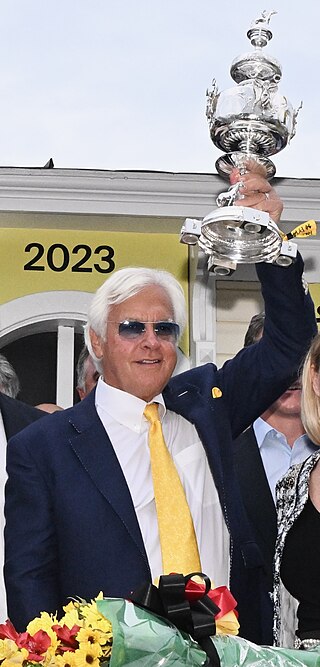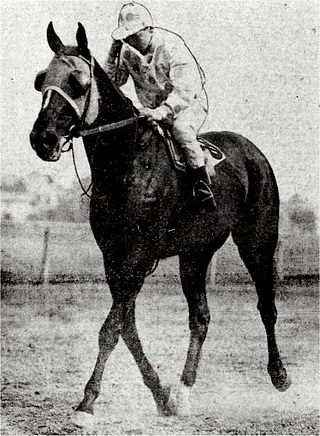Related Research Articles

The Belmont Stakes is an American Grade I stakes race for three-year-old Thoroughbreds run at Belmont Park in Elmont, New York. It is run over the worldwide classic distance of 1+1⁄2 miles. Colts and geldings carry a weight of 126 pounds (57 kg); fillies carry 121 pounds (55 kg). The race, nicknamed The Test of the Champion, The Test of Champions and The Run for the Carnations, is the traditional third and final leg of the Triple Crown. It is usually held on the first or second Saturday in June, five weeks after the Kentucky Derby and three weeks after the Preakness Stakes. The 1973 Belmont Stakes and Triple Crown winner Secretariat holds the track record of 2:24.
Cañonero II was a Venezuelan champion Thoroughbred race horse that may be best remembered for winning the first two legs of the 1971 U.S. Triple Crown, the Kentucky Derby and the Preakness Stakes.

Mr. Prospector was a Thoroughbred racehorse who became an outstanding breeding stallion and notable sire of sires. A sprinter whose career was cut short by repeated injuries, he won seven of his 14 starts, including the Gravesend Handicap at Aqueduct Racetrack and the Whirlaway Handicap at Garden State Park.

Robert A. Baffert is an American racehorse trainer who trained the 2015 Triple Crown winner American Pharoah and 2018 Triple Crown winner Justify. Baffert's horses have won a record six Kentucky Derbies, eight Preakness Stakes, three Belmont Stakes, and three Kentucky Oaks. He has been the subject of significant controversy regarding repeated incidents of his horses failing drug tests or dying under his care.
Thoroughbred Racing on NBC is the de facto title for a series of horse races events whose broadcasts are produced by NBC Sports, the sports division of the NBC television network in the United States. NBC's relationship with the Triple Crown of Thoroughbred Racing dates back to 1949 when the NBC Red Network carried the first radio broadcast of the Kentucky Derby.

Victor Espinoza is a jockey in American Thoroughbred horse racing who won the Triple Crown in 2015 on American Pharoah. He began riding in his native Mexico and went on to compete at racetracks in California. He has won the Kentucky Derby three times, riding War Emblem in 2002, California Chrome in 2014, and American Pharoah in 2015. He also won the Preakness Stakes three times, in those same years and with the same horses. He was the first jockey in history to enter the Belmont Stakes with a third opportunity to win the Triple Crown; his 2015 victory made him the oldest jockey and first Hispanic jockey to accomplish the feat.
Edward Riley Bradley was an American steel mill laborer, gold miner, businessman and philanthropist. As well as a race track proprietor, he was the preeminent owner and breeder of Thoroughbred racehorses in the Southern United States during the first three decades of the 20th century. Testifying before a United States Senate committee in April 1934, Bradley identified himself as a "speculator, raiser of race horses and gambler". He appeared on the cover of Time magazine on May 7, 1934. In the year 2000, the Florida Department of State honored him as one of their Great Floridians.

Peter Pan (1904–1933) was an American Thoroughbred racehorse and sire, bred and raced by prominent horseman, James R. Keene. As winner of the Belmont Stakes, the Brooklyn Derby and the Brighton Handicap, he was later inducted into the National Museum of Racing and Hall of Fame. His progeny included many famous American racehorses, including several winners of the Kentucky Derby and the Preakness Stakes.

Hourless (1914–1935) was a British-born Thoroughbred racehorse who raced in the United States where he won the 1917 Belmont Stakes.

In the United States, the Triple Crown of Thoroughbred Racing, commonly known as the Triple Crown, is a series of horse races for three-year-old Thoroughbreds, consisting of the Kentucky Derby, Preakness Stakes, and Belmont Stakes. The three races were inaugurated in different years, the last being the Kentucky Derby in 1875. The Triple Crown Trophy, commissioned in 1950 but awarded to all previous winners as well as those after 1950, is awarded to a horse who wins all three races and is thereafter designated as a Triple Crown winner. The races are traditionally run in May and early June of each year, although global events have resulted in schedule adjustments, such as in 1945 and 2020.
Dr. Freeland was an American Thoroughbred racehorse best known for his win in the Preakness Stakes, the then first leg of the 1929 United States Triple Crown of Thoroughbred Racing. He was named for Dr. John Freeland, a prominent New York City banker.

Oxbow, an American Thoroughbred racehorse, is best known for winning the second jewel in the United States Triple Crown of Thoroughbred Racing, the 2013 Preakness Stakes. A bay colt, sired by a winner of the Breeders' Cup Classic and out of a full sister to another Breeders' Cup Classic winner, Oxbow was sold as a yearling at Keeneland for $250,000 and is owned by Brad Kelley of Calumet Farm. He was trained by D. Wayne Lukas and was ridden in his Triple Crown races by Gary Stevens.
The 2003 Belmont Stakes was the 135th running of the Belmont Stakes. The 1+1⁄2-mile (2,400 m) race, known as the "test of the champion" and sometimes called the "final jewel" in thoroughbred horse racing's Triple Crown series, was held on June 7, 2003, three weeks after the Preakness Stakes and five weeks after the Kentucky Derby.
The 1928 Preakness Stakes was the 53rd running of the Preakness. The race took place on Friday, May 11, 1928, eight days before the Kentucky Derby making it the first leg of the U.S. Triple Crown series. A horse race for three-year-old thoroughbreds, it carried a total purse of $71,370. It was run on a track rated fast in a final time of 2:00 1/5. Ridden by future U.S. Racing Hall of Fame inductee Raymond Workman, Victorian won the race by a nose over runner-up Toro. Nassak, the betting favorite from the powerful Rancocas Stable finished a distant 11th. The fifth-place finisher, Sun Beau, went on to a brilliant racing career and was voted U.S. Champion Older Horse in three straight years culminating with his 1996 induction into the U.S. National Museum of Racing and Hall of Fame.
The 1899 Preakness Stakes was the 24th running of the $1,000 added Preakness Stakes, a horse race for three-year-old Thoroughbreds run on May 30, 1899 at the Gravesend Race Track on Coney Island, New York. The mile and a sixteenth race was won by Half Time over runner-up Filigrane. The race was run on a track rated fast in a final time of 1:47 flat that equaled the Gravesend track record for the distance.
The 1899 Belmont Stakes was the 33rd running of the Belmont Stakes. It was the 10th Belmont Stakes held at Morris Park Racecourse in Morris Park, New York, and was run on May 25, 1899. The race drew four starters and was won by favored Jean Bereaud whose winning time of 2:23 flat set a new Morris Park track record for 1 3⁄8 miles on dirt.
The 1910 Belmont Stakes was the 44th running of the Belmont Stakes. It was the 6th Belmont Stakes held at Belmont Park and was run on May 30. The race drew only two starters and was won by future U.S. Racing Hall of Fame jockey James Butwell riding the favorite Sweep. The colt cantered most of the way and won by six lengths with ease, reflected in the slow time of 2:22 flat for the 1 3⁄8 miles on dirt.
The 1895 Preakness Stakes was the 20th running of the $1,000 added Preakness Stakes, a horse race for three-year-old Thoroughbreds run on May 25, 1895 at Gravesend Race Track, in Coney Island, New York. Ridden by Fred Taral, Belmar won the mile and a sixteen race by one length over runner-up April Fool. The race was run on a track rated fast in a final time of 1:50 1/2.
The Chesapeake Stakes was an important American Thoroughbred horse race for three-year-old horses of either sex contested on dirt over a distance of a mile and one-sixteenth at Havre de Grace Racetrack in Havre de Grace, Maryland. Run from 1920 until the track closed after the 1950 edition, the race usually run in late April race was a last major prep before the Kentucky Derby. For owners who had not nominated their horse for the Derby it was a chance to test their horse's ability against some of the best three-year-olds in the country, a number of which they would undoubtedly encounter in the ensuing Preakness Stakes.
The 1901 Belmont Stakes was the 35th running of the Belmont Stakes. It was the 12th Belmont Stakes held at Morris Park Racecourse in Morris Park, New York and was run on May 23, 1901. The race drew three starters and was won by the heavily favored Commando whose winning time of 2:21 flat set a new record for the Belmont Stakes at the 1+3⁄8 miles distance on dirt.
References
- ↑ "The Parader Won Easily". New York Times, page 6. May 29, 1901. Retrieved January 1, 2019.
- ↑ "1901 Kentucky Derby Results Tables" (PDF). Archived from the original (PDF) on August 14, 2011. Retrieved November 27, 2010.
- ↑ "1901 Belmont" (PDF). Belmontstakes.com. May 23, 1901. Retrieved June 3, 2021.
- ↑ "Preakness Stakes Winners". twinspires. June 4, 2021. Retrieved June 4, 2021.
- ↑ U.S. Racing Hall of Fame" Thomas J. Healey Archived February 26, 2021, at the Wayback Machine
- ↑ Liebman, Bennett (April 24, 2008). "The Rail: The Race for the Triple Crown - Origins of Triple Crown". The New York Times . New York, NY. Retrieved May 9, 2009.